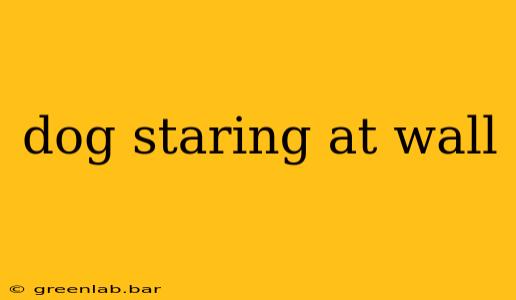Is your canine companion suddenly fixated on a seemingly empty wall? Don't worry, you're not alone. Many dog owners find themselves puzzled by their dog's intense staring at walls, a seemingly odd behavior that can range from mildly curious to downright concerning. This article delves into the potential reasons behind this peculiar behavior, helping you understand your furry friend better and address any underlying issues.
Common Reasons for Wall-Staring in Dogs
While a quick glance at the wall is normal, prolonged, intense staring warrants a closer look. Here are some of the most common explanations:
1. Prey Drive and Focus:
Dogs, even pampered house pets, retain their ancestral hunting instincts. They might be fixated on something they see—a bug, a small animal, or even a reflection—that's invisible to us. Their intense focus could be a manifestation of their natural prey drive. Consider checking the wall carefully for any tiny creatures or unusual movement.
2. Sensory Stimulation:
Dogs have a far more acute sense of smell and hearing than humans. They may be picking up on subtle scents or sounds emanating from behind the wall, like insects, rodents, or even plumbing issues. This heightened sensory awareness could explain their seemingly inexplicable fascination.
3. Cognitive Dysfunction Syndrome (CDS):
In older dogs, staring at walls can sometimes be a symptom of Cognitive Dysfunction Syndrome, a condition similar to dementia in humans. Other signs of CDS include disorientation, changes in sleep patterns, and decreased interaction. If your senior dog suddenly exhibits this behavior alongside other concerning symptoms, consult your veterinarian.
4. Medical Conditions:
Certain medical conditions, including neurological problems or vision impairments, can lead to unusual behaviors like staring at walls. If the staring is accompanied by other symptoms like seizures, changes in gait, or loss of appetite, veterinary attention is crucial.
5. Anxiety or Stress:
Just like humans, dogs can experience anxiety and stress. Staring at a wall might be a way for your dog to self-soothe or focus on something to alleviate their anxiety. Identifying and addressing the source of their stress is vital. Consider environmental factors, changes in routine, or potential triggers.
6. Boredom or Lack of Stimulation:
Sometimes, the simplest explanation is the best. If your dog isn't getting enough mental or physical stimulation, staring at a wall might simply be a sign of boredom. Ensure your dog gets adequate exercise, playtime, and mental enrichment through puzzles or training sessions.
What to Do If Your Dog is Staring at the Wall:
- Observe: Note the duration and frequency of the wall-staring. Are there any other accompanying behaviors?
- Check the Environment: Thoroughly examine the wall and surrounding area for potential stimuli.
- Rule Out Medical Issues: Schedule a veterinary appointment if the behavior is new, persistent, or accompanied by other symptoms.
- Provide Enrichment: Ensure your dog gets sufficient exercise, mental stimulation, and social interaction.
- Address Anxiety: If anxiety is suspected, consult with a veterinarian or a certified dog behaviorist.
Understanding your dog's behavior is key to ensuring their well-being. While wall-staring might seem insignificant, it can be a window into their internal world, hinting at underlying needs or potential health concerns. By carefully observing your dog and seeking professional help when necessary, you can ensure your furry friend remains happy, healthy, and engaged.

